Protecting Mopheads and Lacecaps in Winter
The information on this page is for H. macrophylla, which is the typical blue and pink mophead or lacecap hydrangea. Paniculata and smooth hydrangeas do not need protection in the United States and most of Canada.
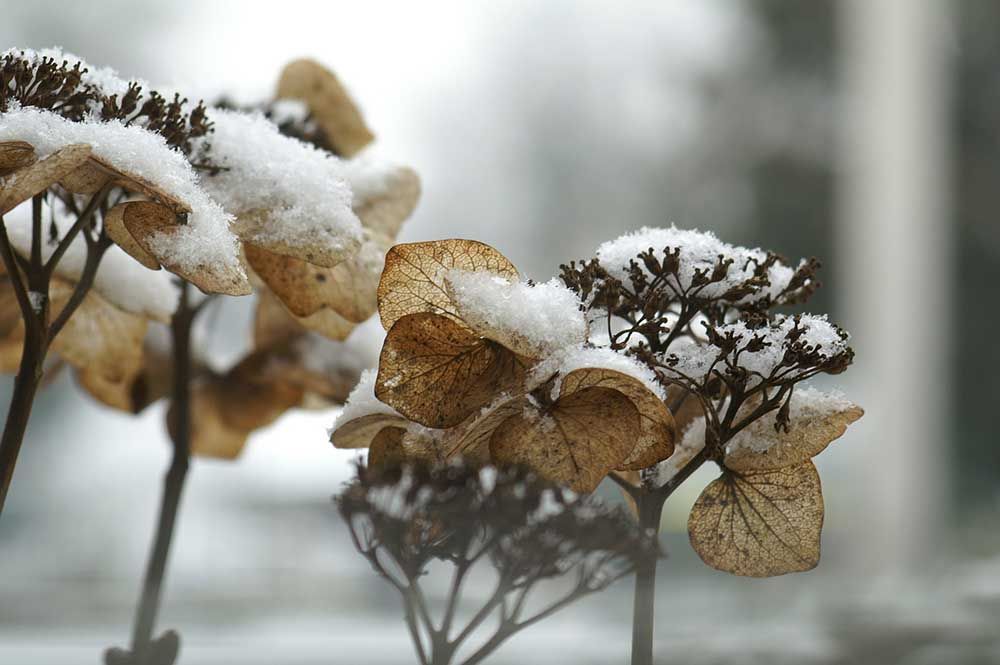
Hydrangeas that experience winter temperatures of no less than 5-10 degrees do not need winter protection. If the temperature falls into the single digits for only a few hours at a time, the hydrangea should not be harmed.
NOTE: One word of warning- Before purchasing a hydrangea that you know will need winter protection to bloom in your area, keep this in mind. While the hydrangea is small it will be easy to protect, but as it grows larger, the task will become much more difficult and may, in time, grow too tedious to continue.
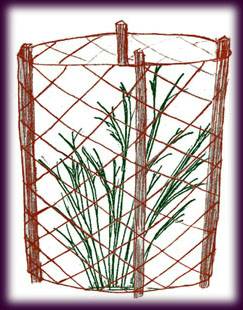 Suggestions for Winter Protection
Suggestions for Winter Protection
Most methods of protection start with a frame around the hydrangea. This can be sturdy stakes surrounded by chicken wire, burlap, or other material that allows air to circulate (Plastic is not recommended although some find it useful).
The sketch to the right (a copy of which you will undoubtedly want to order for your art collection) shows a dormant hydrangea surrounded by a wire cage. (One reader suggested lining the inside of this cage with cardboard)
Next, an insulating material such as oak leaves, pine straw, or something similar, is worked down into the enclosure. Be careful not to break the tips off any of the branches as this is where the flower buds have already formed. (One reader suggested enclosing the entire cage, at this point, with insulation cloth.) This must be left on the hydrangea all winter and into the spring until the last possible frost has past. When it is uncovered, the hydrangea will already have started to leaf out.
Important: Since hydrangeas tend to set their blooms on the ends of the branches, it is important to keep these covered all winter. Most insulating materials will pack down somewhat during the winter and expose the branch tips, so the material must either be replaced or secured in place.
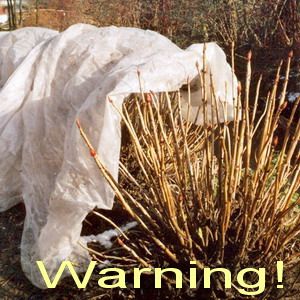 WARNING: Luc Balemans, a hydrangea expert in Belgium, warns that some winter covers (similar to the one at the left) may rub the ends off the branches in windy weather and, in turn, rub off the bloom buds. These all-important bloom buds on branch ends should be protected with a layer of leaves or other material before covering.
WARNING: Luc Balemans, a hydrangea expert in Belgium, warns that some winter covers (similar to the one at the left) may rub the ends off the branches in windy weather and, in turn, rub off the bloom buds. These all-important bloom buds on branch ends should be protected with a layer of leaves or other material before covering.
As mentioned above, leaves often settle during the winter, leaving delicate buds exposed. One gardener suggests that oak leaves are particularly effective insulation since they do not pack down like other material. Another gardener recommended keeping extra bags of leaves in an area where they will not freeze. These can then be used to refresh the leaf insulation as it settles over the winter. For those that don't have time to go to your local garden center or looking for something a little cheaper we were able to find some good options online.
Protecting Hydrangeas in Ontario, Canada
Below is a picture of the "snowcone" that protects Sylvia's 'Lemon Wave' hydrangea (makes me what to add eyes and a carrot nose!).
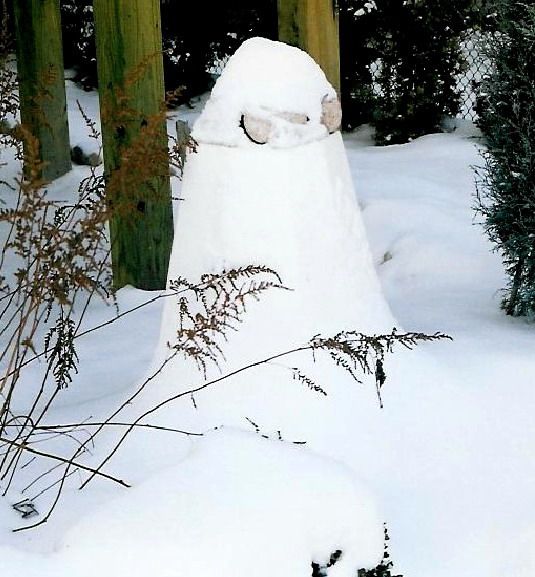
The snow cone is a purchased Styrofoam cone. Sylvia gardens in Ontario, Canada. She says that each fall she "snips off the branches so they will fit under my snow cone. Even though I lose some buds, I still get plenty for the next summer. I tie them together with rope and then put the snow cone over. I stuff the snow cone with dry clippings from my boxwood hedge."
This hydrangea has been growing in Sylvia's garden for 5 years.
WARNING: Snipping off the ends of the stems of most hydrangeas causes some flower loss unless it is done before August.
Protecting Hydrangeas in Massachusetts
Bob, in Massachusetts, has developed an interesting twist to the common method of protecting hydrangeas with an insulated cage. Bob was having difficulty with moisture seeping through the leaves and freezing on the plant. He states that the reasons for using Styrofoam over the cage is "the Styrofoam will protect the plant from severe freezing, as well as preventing snow from melting and saturating the leaves which would then freeze, encapsulating the hydrangea buds. This would probably kill them." Maybe his being a retired mechanical design engineer explains why this structure is so perfectly and carefully made. Below is a picture of the top half of the cage surrounding one of his hydrangeas.
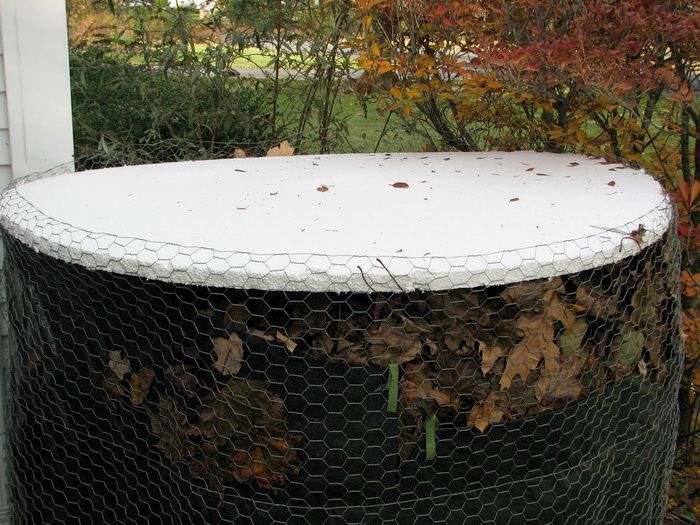
The following is a description of Bob's procedure:
1. Fill plant with leaves (carefully stuff leaves into the branches of the plant)
2. Pull outer stems vertical (up) and tie them together.
3. Place 4' high fencing, lined on the inside with plastic sheeting, around the plant, leaving 1 foot of space all around.
4. Fill this space with leaves (being careful not to knock off any buds)
5. Bring ends of fence together, and overlap so as to partially compress the leaves, and secure.
6. Fill to the top with leaves.
7. Cut a 4 foot diameter x 1" thick piece of Styrofoam and force inside the top of the fence, contacting the leaves.*
8. If your hydrangea is smaller, a 2 foot or 3 foot diameter of Styrofoam may be cut.
*Bob says that sheets of Styrofoam can be purchased at home goods department store in various thicknesses. He uses a "radius compass" to draw the circle on the Styrofoam, but I imagine a pencil on a string would also work for us non-engineers. ;)
OTHER IDEAS FOR PROTECTING POTTED HYDRANGEAS
Protecting hydrangeas in large planters with foam.
Not pretty but gets the job done!
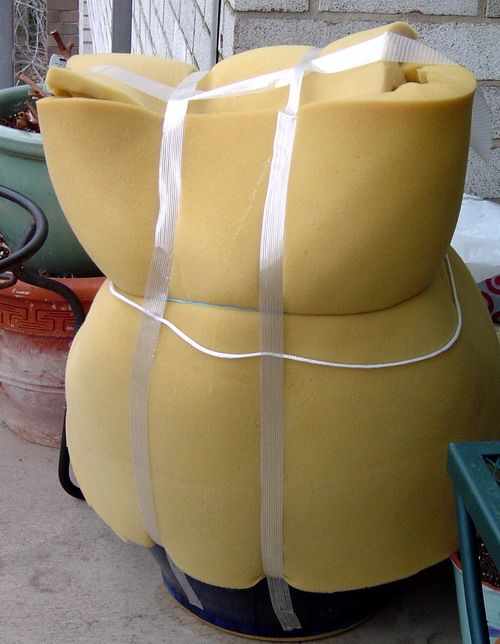
Protecting Potted Hydrangeas With Insulation
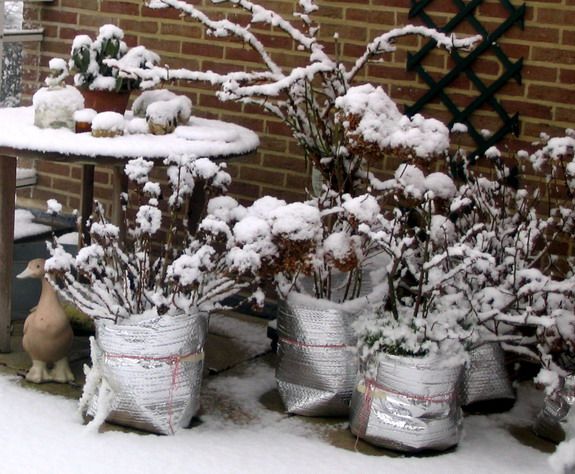
AN UNUSUAL WAY TO PROTECT HYDRANGEAS - FLATTEN THEM !
NOTE: As with several techniques on this site, we can neither recommend the following technique nor take credit for it. But it is such a wonderfully creative and unusual idea, that I wanted to share it with the visitors to this site. This is a highly unconventional way to protect hydrangeas sent to me from a Canadian visitor to this site (Maria).
I can give you no more information other than what you will read below. Basically, Maria describes how she flattens her whole hydrangea plant beneath sheets of cardboard and bricks. Maria writes:
"I live In Ottawa, Ontario Canada, and have been a very crazy hydrangea fan. In my very large previous garden I had quite a large collection of them. I was told by an old German lady that owns one of the nurseries here to cover hydrangeas this way, and it does work.
Find a middle of the shrub, gently push down each side of the plant (groups of branches) towards the ground, cover each with cardboard. (hunt for large TV boxes). When they get larger, I need help to hold them down. I use bricks to hold down the cardboard, then I put leaves over it all, and then white insulating cloth, and finally more brick to hold it all down. Later, the snow helps to push the whole thing down,.. and it has worked for me in this climate. Love your site, Maria"
In another e-mail, Maria assured me that the hydrangeas pop back up in the spring and look like normal hydrangea shrubs. Isn't this amazing? I wish she'd sent a picture!
Protecting Hydrangeas as Christmas Presents!
We absolutely love this idea from Katelin Alison. She was feeling very creative, and after winterizing her hydrangeas, she proceeded to wrap them like giant presents. What a great idea!
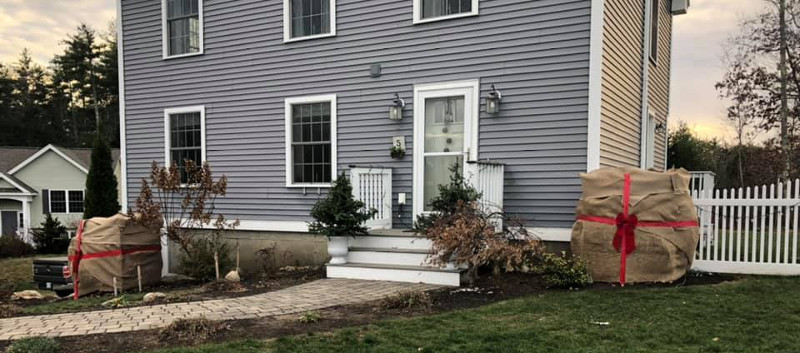
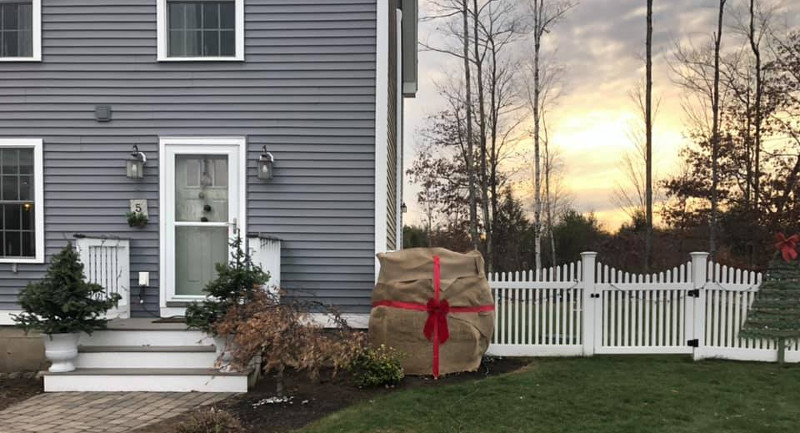
HYDRANGEAS IN POTS
If you live in a very cold area, you might try growing hydrangeas in large pots and putting them in a cellar or garage that freezes only lightly.
Admittedly, large pots are difficult to handle, but hydrangeas will NOT do well in smaller pots. Their roots are too aggressive and quickly fill the smaller pots.
 |
Author Judith King - Published 10-17-2017 |
